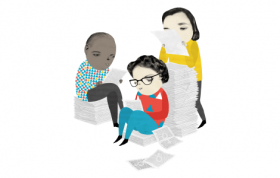The Nordic Countries Dealing with Gender Inequality in Academia
Although a majority of undergraduate students are women, higher up in the academic hierarchy is clearly a man’s world. About 80 per cent of all professors at Nordic higher education institutions are men, but efforts to reach gender equality in academia are underway.
The problem of unequal gender distributions is widespread among Nordic universities. The trend is similar everywhere: more women than men begin and complete a Bachelor’s degree. Then something happens, and the women disappear. Female professors are vastly outnumbered by their male counterparts. The issue is receiving increasing attention and will be discussed at a meeting for Nordic ministers of education (MR-U) on 27 April.
‘The initiative comes from Denmark, who wants to discuss the problem at the Nordic level. It’s especially the situation at the higher academic levels that will be discussed. We’ll see what the meeting leads to,’ says Kai Koivumäki, senior adviser at the Nordic Council of Ministers’ Department of Knowledge and Welfare.
Men are dominating at the top
Statistics from 2012 show that the share of female professors varies across the Nordic region. Iceland and Finland have the largest shares, at 24 per cent. In Sweden the share is 20 per cent and in Norway 21 per cent, a level similar to the EU average. Denmark has the biggest problem, as only about 15 per cent of all professors at Danish higher education institutions were women in 2012.
The Nordic Council of Ministers has now decided to take action. In March, Nordforsk, which is in charge of Nordic co-operation in research and postgraduate education, decided to appoint a programme committee for the initiative Gender in the Nordic Research and Innovation Area. The aim of the programme is to produce new knowledge that can be used to both directly and indirectly deal with the imbalance between men and women in research and innovation in the Nordic countries. The programme is scheduled to end in 2020 and will for example produce gendered statistics at Nordic level, fund research on the issue and increase knowledge.
‘Nordforsk is the organisation under the Nordic Council of Ministers that’s in charge of these issues. They have prepared material for the discussion at the meeting,’ says Koivumäki.
Expert groups in Denmark and Sweden
Also the individual Nordic countries are working actively to solve the problem. Sweden recently appointed a national expert group for gender equality in academia, and Denmark has had a special taskforce in place since December.
‘Statistics show that the number of women falls dramatically at higher levels in research. Why is that? The expert group has looked closer at this question and will present solutions based on the knowledge we have today,’ says Johnny K. Mogensen, head of the Danish Agency for Science, Technology and Innovation at the Danish Ministry of Higher Education and Science.
Often only male applicants
The Danish expert group will soon present the outcome of its work. Mogensen says that the recommendations will concern several different areas, including recruitment processes.
‘Not all jobs in academia get advertised. And when they are, the criteria described in the advertisement can be very narrow and specific. Statistics show that many advertised postdoc positions lack female applicants. And when professors are recruited, this happens in three out of four cases,’ he says.
Other recommendations concern how to create a good work environment in academia for both women and men. The expert group will also address traditional gender patterns and their relevance in relation to the statistics.
‘Maybe a person’s assessment of his or her competence is affected by notions of gender and makes women place higher demands on themselves. This may explain why they don’t apply for top positions in academia,’ says Mogensen.
- Text: NIKK
- Categories: Gender equality and welfare policy
- Published: 2015-04-24



